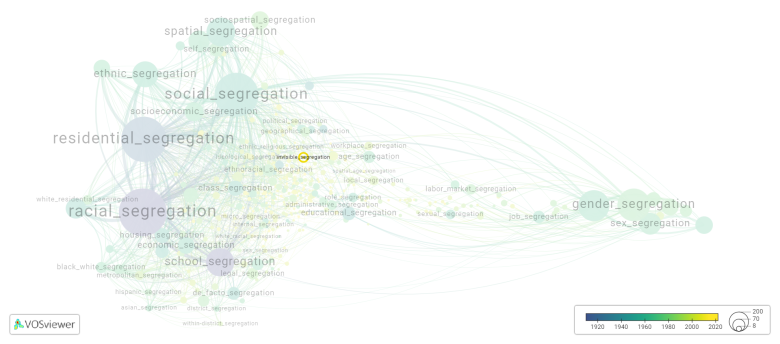Invisible segregation: Difference between revisions
(Creating page) |
(Creating page) |
||
| (10 intermediate revisions by 2 users not shown) | |||
| Line 1: | Line 1: | ||
===== Date and country of first publication<ref>Date and country of first publication as informed by the Scopus database (December 2023).</ref>===== | |||
2022<br> | |||
Iran | |||
===== Definition ===== | |||
Invisible segregation refers to subtle forms of segregation or exclusion that are not immediately obvious or overt, but are present in social, economic, or cultural settings. This can include things like disparities in access to resources, opportunities, or social networks based on factors such as race, gender, or socioeconomic status. Invisible segregation can also manifest in the form of implicit biases or discriminatory practices that perpetuate inequality and marginalization. | Invisible segregation refers to subtle forms of segregation or exclusion that are not immediately obvious or overt, but are present in social, economic, or cultural settings. This can include things like disparities in access to resources, opportunities, or social networks based on factors such as race, gender, or socioeconomic status. Invisible segregation can also manifest in the form of implicit biases or discriminatory practices that perpetuate inequality and marginalization. | ||
==See also== | ==See also== | ||
==Related segregation forms== | |||
Invisible segregation is frequently discussed in the literature with the following segregation forms: | |||
[[social segregation]] | |||
[[File:invisible_segregation.png|780x780px]] | |||
This visualization is based on the study [[Segregation_Wiki:About| The Multidisciplinary Landscape of Segregation Research]]. | |||
For the complete network of interrelated segregation forms, please refer to: | |||
* [https://tinyurl.com/2235lkhw First year of publication] | |||
* [https://tinyurl.com/2d8wg5n3 Louvain clusters] | |||
* [https://tinyurl.com/223udk5r Betweenness centrality] | |||
* [https://tinyurl.com/244d8unz Disciplines in which segregation forms first emerged (Scopus database).] | |||
==References== | ==References== | ||
== | ==Notes== | ||
<references /> | |||
{{NoteAI}} | |||
==Invisible segregation appears in the following literature== | |||
Ghazaie M., Rafieian M., Dadashpoor H. (2022). Making the invisible segregation of diverse neighbourhoods visible. ''Journal of Housing and the Built Environment'', ''37''(1), 459-482. Springer Science and Business Media B.V..https://doi.org/10.1007/s10901-021-09850-z | |||
Latest revision as of 07:17, 16 October 2024
Date and country of first publication[1][edit | edit source]
2022
Iran
Definition[edit | edit source]
Invisible segregation refers to subtle forms of segregation or exclusion that are not immediately obvious or overt, but are present in social, economic, or cultural settings. This can include things like disparities in access to resources, opportunities, or social networks based on factors such as race, gender, or socioeconomic status. Invisible segregation can also manifest in the form of implicit biases or discriminatory practices that perpetuate inequality and marginalization.
See also[edit | edit source]
Related segregation forms[edit | edit source]
Invisible segregation is frequently discussed in the literature with the following segregation forms:
This visualization is based on the study The Multidisciplinary Landscape of Segregation Research.
For the complete network of interrelated segregation forms, please refer to:
References[edit | edit source]
Notes[edit | edit source]
- ↑ Date and country of first publication as informed by the Scopus database (December 2023).
At its current state, this definition has been generated by a Large Language Model (LLM) so far without review by an independent researcher or a member of the curating team of segregation experts that keep the Segregation Wiki online. While we strive for accuracy, we cannot guarantee its reliability, completeness and timeliness. Please use this content with caution and verify information as needed. Also, feel free to improve on the definition as you see fit, including the use of references and other informational resources. We value your input in enhancing the quality and accuracy of the definitions of segregation forms collectively offered in the Segregation Wiki ©.
Invisible segregation appears in the following literature[edit | edit source]
Ghazaie M., Rafieian M., Dadashpoor H. (2022). Making the invisible segregation of diverse neighbourhoods visible. Journal of Housing and the Built Environment, 37(1), 459-482. Springer Science and Business Media B.V..https://doi.org/10.1007/s10901-021-09850-z

